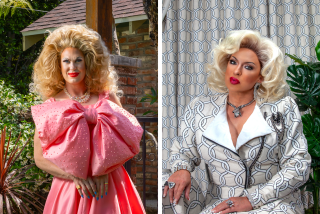A Game With a Point : Recreation: In 1989, about 10% of those polled said they played darts at least once a year, matching the number of those who said they played baseball. The game’s popularity continues to increase.
- Share via
The aim of Paul Lim, a 35-year-old ex-chef from San Bernardino, is deadlier than that of a pit viper.
Cunningly silent, he uncoils his right forearm and opens his fingers, sending a sleek missile hissing toward its target.
Thonk. Triple 20.
Joining Lim in the hunt is Sandy Reitan, a 37-year-old Torrance resident whose cool but intense concentration in front of a dart board has earned her the nickname “Ice Queen.”
In one deft stroke, she puts her dart within a whisker’s width of Lim’s.
The two world-class players would meet in a dark alley for the chance to play each other, but the venue for their latest confrontation is the Bellflower living room of Tom Fleetwood, founder and executive secretary of the 100,000-member American Darts Organization, or ADO.
“C’mon you guys, break it up. We have to be at the (photographer’s) studio at 10:30 a.m.,” says Fleetwood, an organizer and promoter whose eye for publicity is as sharp as Lim’s and Reitan’s aim.
But Fleetwood’s job has already been made easy.
On Jan. 9 at the Embassy World Professional in London, Lim stunned a BBC television audience of 7 million by throwing a perfect 501 game with nine darts (seven triple 20s, one triple 19 and one double 12). The feat, seen only one other time on television, was worth 50,000, the largest single payout in the annals of darts.
“I compare it to Don Larsen’s perfect World Series game,” says Fleetwood. “Twenty-seven up and 27 down.”
Reitan’s pockets also have a silver lining. A five-time national champion, she won the World Cup in Edinburgh in 1983 and with it the ranking as the best woman player in the world. In 1987, she captured the Japan World Darts Grand Prix, earning 3 million yen, about $25,000.
These are clearly good times for Fleetwood and his fellow darters.
In 1989, the Gallup Leisure Activities Index listed darts for the first time among its annual survey of recreational pursuits. About 10% of those who responded to the poll said they played darts at least once a year, matching the number of those who said they play baseball.
Moreover, the July, 1989, issue of Retail Focus, a trade publication of the National Sporting Goods Assn., reported that dart throwing was the nation’s 19th most popular participant sport, with an estimated 17.8 million players, putting it ahead of such pastimes as tennis (20th), baseball (23rd) and racquetball (29th).
While darts has a rich tradition as a pub game, players are setting up boards everywhere from home basements to hotel ballrooms.
“If there are 100,000 registered ADO members and 18 million players, they’ve got to be playing somewhere,” Fleetwood said.
Cashing in on the game’s popularity is Bottlesen Dart Co. in Santa Maria, the state’s largest dart manufacturer with sales of more than 1,000 sets a week, in 300 styles.
“This isn’t a one-shot fad like the Hula-Hoop craze,” says Michael Wines, general sales manager. “It’s way beyond that.”
Fleetwood attributes the boom to budget-conscious Americans looking for a sport that is entertaining and challenging.
“For a sawbuck, you can purchase a beginner’s set of darts and play until you’re blue in the face,” Fleetwood says. “The combinations are always different, and the outcome is always in doubt until the final dart is thrown.”
Further evidence of a boom: The Culver City-based Southern California Darts Assn. has grown from six teams in 1976 to 375 in 1990. Glenn Standley, the association’s president, cites several factors that helped propel the upward flight of darts.
“There’s a quaint, gentlemanly air to the sport,” Standley says. “There’s no hustle to it. It’s simply you against the board. Everything is out front.”
Standley’s observation was right on target one night. After a 14-hour day to wrap up a year-end report, Buzz Grant, a financial manager with Dunlop Aviation, and Ken Samoorian, an independent auditor, never bothered to loosen their ties during an evening match at the Robin Hood tavern in Van Nuys.
“Certain standards must be upheld,” Grant said.
Despite the tony, button-down look of Grant and Samoorian, darts remain a strongly egalitarian sport, Standley said.
“In open-draw tournaments, the average player, even the beginner, has the opportunity to play against or with world-caliber players. I can think of no other sport where you can do that.
“If you wanted to play Jack Nicklaus in golf or Boris Becker in tennis, you’d have to pay a king’s ransom. But with darts, you’re talking about a nominal $5 to $10 fee to play with the very best.”
Reitan calls her set of Unicorn darts her favorite traveling companions, next to her dart-playing husband, Andy Green.
“I can take my three darts anywhere in the world and meet new people and make new friends,” says Reitan, who owns and operates the Dart Shoppe in Anaheim.
Although men outnumber women darters by about two to one, according to John Muldoon, owner of Dueling Darts in Bellflower, women may have an upper hand in the sport.
“Darts is not a muscle game,” says Muldoon. “It’s all about finesse, and that’s why a lot of women have the advantage in this game and don’t even know it.”
Maureen Griffith, an engineering and anthropology major at Cal State Northridge, also believes women have a subtle edge over men players; she even wrote a term paper to prove her point.
“Brains, not brawn, is what it takes to win,” says Griffith. She belongs to a women’s team that plays out of the Royal Oak, a converted biker bar in North Hollywood.
Any student of the slings and arrows of outrageous fortune should also know the history (read: legend) of darts, as well as a few of the rules (read: traditions) governing the game.
According to William Fitzgerald, owner of the Crest Restaurant and Bar in Torrance and co-author of “All About Darts,” English soldiers hurled their lances into the upturned ends of empty wine barrels. As a shortage of wine barrels developed, they began using round slices of felled trees for target practice.
Fitzgerald surmises that the concentric rings of the tree proved ideal for scoring purposes while the cracks in the wood gave the radial lines for selection of score areas.
“Here we see the beginnings of our carefully spoked modern dart board,” he says.
As the British Empire expanded, dart clubs soon stretched from Brighton to Burma. Even the Pilgrims are credited with playing darts aboard the Mayflower.
During World War I, Fitzgerald notes, British aviators hunted for zeppelins and dropped steel darts on the German airships.
In the modern era, darts travel 7 feet, 9 1/4 inches from the toe line, which for some--or no--reason is called the “hockey line,” to the board; the distance from the floor to the bull’s-eye is 5 feet, 8 inches.
The real fun or frustration begins after the dart strikes one of the board’s 20 wedges, where low numbers flank high numbers. If the dart lands in the outer ring, point values double; if it lands in the inner ring, point values triple. The outer circle of the bull’s-eye is worth 25, the bull’s-eye itself 50.
Many of these number combinations come into play in a popular game called 301, in which the winner has to get his score down to zero before the opponent does. After doubling in, the player subtracts from 301 the score of each thrown dart. To “punch the finish,” however, the player must also double out. In other words, if the player has 32 left to reach zero, he must hit double 16. If a single 16 is scored instead, the player must take aim at a double 8 to go out.
The game of 501 is played exactly the same, except that a double is not required to start the scoring.
“Games may even start at as high as 1001, depending upon the number of players on each team,” said Jimmy Doyle, manager of Des Regan’s Irish pub in Burbank, which will be host of a charity shoot to benefit an child-abuse prevention program.
Another version called cricket is the current rage at many pubs because it emphasizes strategy in addition to individual scoring. The object is to close out the numbers 20 through 15 and the bull’s-eye before your opponent does.
Selecting a set of darts to reflect one’s personality can be as much fun as throwing them in competition.
“They come in all types to satisfy every fetish, fashion and superstition,” Fitzgerald says. “Feathers come in all colors of the rainbow, and sometimes you can find them all on one dart.”
They also come in all signs of the zodiac.
Standley recalls a player who used to come into the dart association’s headquarters and shoot darts with his blow gun.
“He was fairly accurate, but after a while he was too winded to compete,” Standley says.
The choice of weapons, which range in weight from 10 grams to 40 grams, ultimately depends on personal preference--and a few grains of common sense.
“If you earn your living by hauling in cod nets, then I suggest a heavy knurl on a fat dart barrel for a solid grip,” Fitzgerald says.
Interestingly, if your dart flutters like a sick sparrow, the remedy for righting the wayward missile is not to rush out and purchase a new set of darts.
“If you change darts,” shop owner Muldoon says, “you’re just going to come into a new set of problems. Over the long haul, your bad habits will creep back, and you may even develop some new ones.”
Lest such advice cut into his sales, Muldoon also gives lessons.
The sport is seeing some new developments, in keeping with the times.
Emmett Halpin, a 42-year-old former smoker from Wakefield, Mass., is laying the groundwork for an ADO-affiliated league in which alcohol and smoking are banned from the playing area.
“You don’t see a shortstop with a brew,” Halpin says.
Fleetwood says that in World Dart Federation Cup play--the World Cup, Europe Cup, Pacific Cup and Asia Cup--smoking and drinking are prohibited in tournaments, while Japan bans these activities at all competitions.
“But I don’t think there’s any more drinking in darts than there is at bowling or billiards tournaments,” Fleetwood says.
The ADO is also taking aim at adolescent darters who have been unable to compete in taverns, bars and pubs. Through a National Youth League Playoff Program, teen-agers can qualify for major prizes, including scholarships, at district and national competitions.
“We’re training counselors to supervise tournaments at YMCAs, Boys Clubs, church leagues and even inside the home,” says Ken Friend, ADO youth manager. “Kids will charm the socks off a rooster, and they’re a great mechanism to let people know that darts can be played outside the pub.”
Another change energizing the sport is the introduction of soft-tip dart machines with electronic scoreboards. For 25 or 50 cents, the machine will tabulate your score in popular games such as 301, 501 and cricket.
In a major departure from traditional darts, soft-tip leagues assign each player a composite dart average and group the players according to their ability. Also, darts that bounce off the board are still credited with a score.
“We consider electronic dart games a natural evolution of the traditional dart game,” says Joseph Conway, president of the 23,000-member Amusement and Music Operators Assn.’s National Darts Assn. in Milwaukee, Wis.
Mort Ansky, vice president of sales for Merit Industries Inc., which markets the popular Pub Time darts, says electronic dart games are a “no muss, no fuss operation” when compared with traditional darts.
“There’s no more chalk to get on your clothes,” Ansky says. “There’s no more math to compute. It actually talks to you. It’s like driving a car: Green light, you throw the darts; red light, you pull out the darts.
“We’ve just taken the same game and upgraded it with today’s electronics.”
Even die-hard pub owners who once begrudged the new machines much space in their establishments are now finding room for them.
“If you owned a tavern, why would you put up a board that doesn’t pay?” says Ansky. “And with liquor laws limiting consumption, taverns have to offer new forms of adult entertainment to survive.
“Without these machines, a lot of bar owners would be closing their doors,” says Jerry Indik, editor of Shoot the Bull, a newsletter for soft-tip darters in Southern California.
The Nice and Easy bar in Van Nuys is surviving nicely, thanks to four electronic dart games installed about five years ago by Indik’s company, Golden State Darts.
“I think they’re the biggest thing right now,” said owner Priscilla Hsui, who runs 20 soft-tip leagues out of her bar. “They bring mellow people. The pool table brings in the wrong crowd--too rowdy.”
There are an estimated 2,000 soft-tip players in the San Fernando Valley, including Randy Reardon of North Hollywood, who frequents the Nice and Easy.
“Soft-tips are much more accessible than steel-tips,” Reardon says. “You can find them in just about every bar in the valley. They keep track of the score for you, and the machine never lets your opponent win an argument.”
At the John Bull Pub in Pasadena, on the same night that the Nice and Easy had a line leading out the door to play soft-tips, accountants Carmen Patane and Duane Goldsworthy were playing a traditional game of 301. Next to them in the corner, a Pub Time darts machine sat idle.
Why weren’t they playing electronic darts?
Said Patane, who had never tried it: “It looks like a toy, something you’d see at an arcade.”
Some traditions die hard.
Tom Fleetwood, of the American Darts Assn., estimates that from Santa Barbara to San Diego there are 600 to 700 pubs that offer darts. Glenn Standley of the Southern California Dart Assn. offers this advice: If you can’t find a pub within five minutes of where you live, consider changing your mode of transportation.
Listed below are Southland dart associations that can offer you additional assistance:
Antelope Valley Darts Assn.
P.O. Box 2926
Lancaster, Calif. 93560
High Desert Darts Assn.
c/o Bleachers Restaurant & Saloon
42741-F N. 45th St.
West Quartz Hill, Calif. 93534
(805) 722-0271
Rich Kelly, secretary-treasurer.
Indian Wells Darts Assn.
P.O. Box 323
Inyokern, Calif. 93525
Inland Valley Darts Assn.
Lisa Kolb, vice president
3700 Buchanan St., No. 15
Riverside, Calif. 92503
(714) 359-2068 or (714) 881-1377.
Pacific Darts Assn.
Pat Tuell, treasurer
P.O. Box 1350
Cypress, Calif. 90630
(714) 527-6560.
Tri-Counties Darts Conference
Sandi Cain, president
P.O. Box 694
Laguna Beach 92652
(714) 497-2680.
San Gabriel Valley Darts Assn.
Patrick or Arleen Flannery
P.O. Box 2284
Covina, Calif. 91722
(714) 984-4296.
Southern California Darts Assn.
Glenn Standley, president
11119 W. Washington Blvd.
Culver City, Calif. 90230
(213) 839-6972.
More to Read
Go beyond the scoreboard
Get the latest on L.A.'s teams in the daily Sports Report newsletter.
You may occasionally receive promotional content from the Los Angeles Times.










